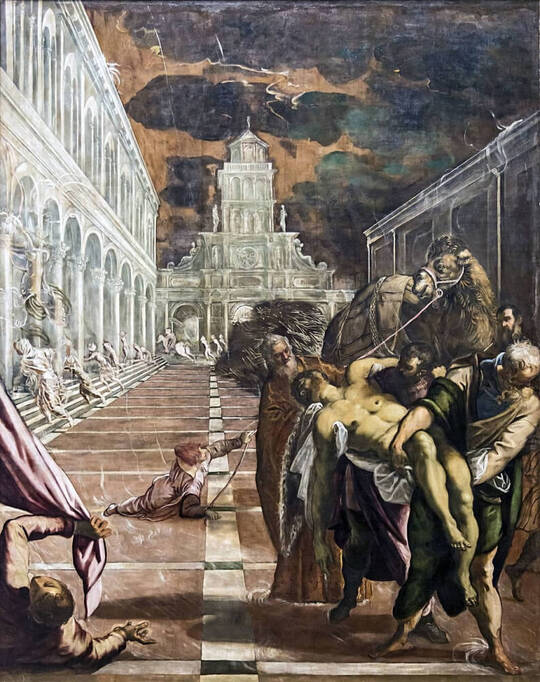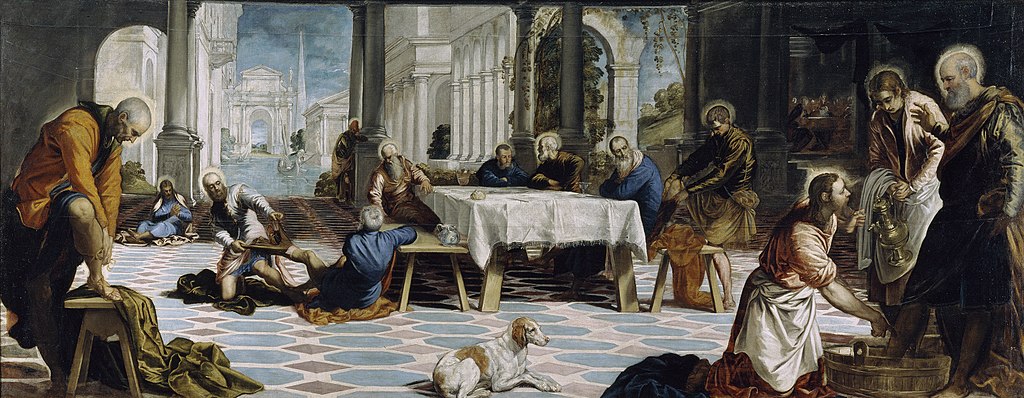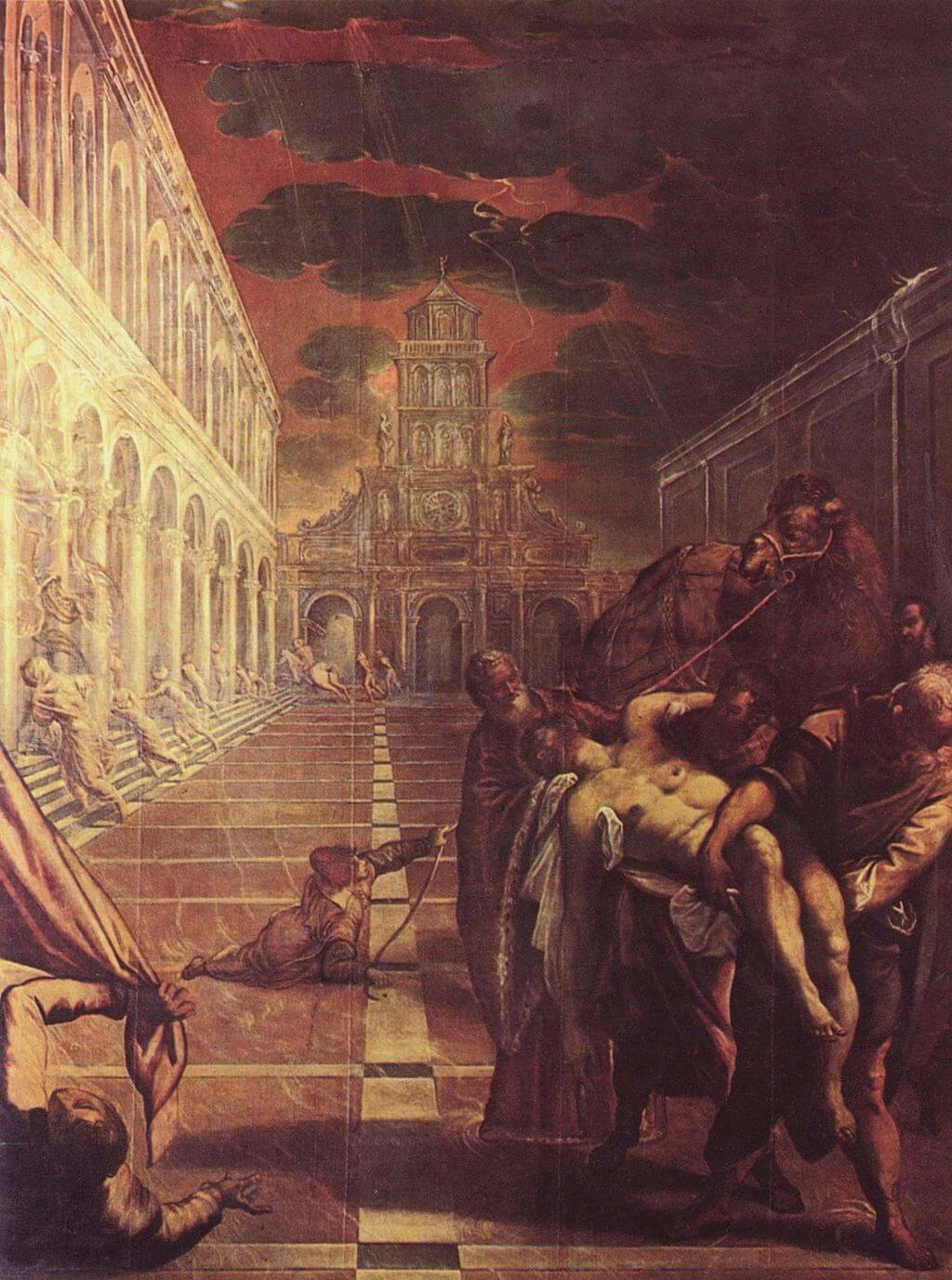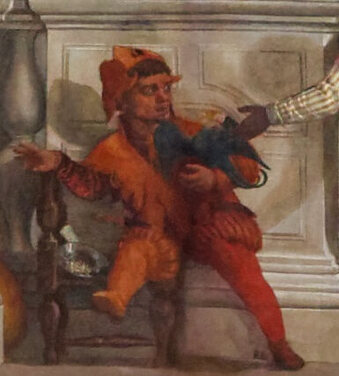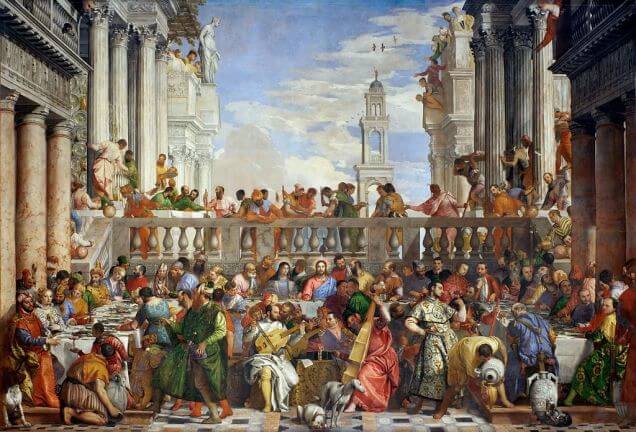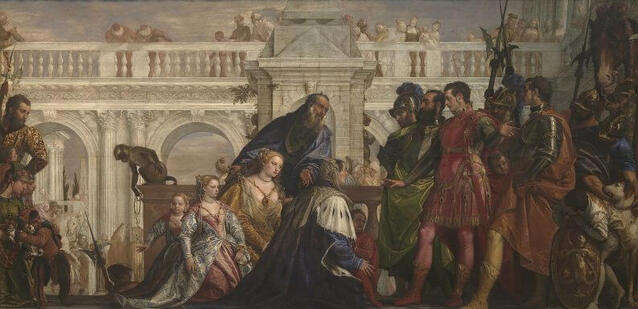|
Where? Room 10 of the Gallerie dell’Accademia
When? 1562-1566 Commissioned by? Tomasso Rangone, a Venetian patron of the arts and the Guardian Grande of a large confraternity in Venice. What do you see? Three people carry the dead body of Saint Mark. The person in the brown robe, holding the head of Saint Mark, is the commissioner of this painting, Tomasso Rangone. The bearded man to the right of dromedary is Tintoretto. In the background is a woodpile on which the body of Saint Mark was supposed to be burned and from which the Christians in this painting stole Saint Mark’s body. The sky in the background is red and dark and contains a lightning strike. The sky refers to the hailstorm that came down at the moment that the killers of Saint Mark wanted to burn him on the pyre. In the left foreground lays a man pulling a cloth. In the original painting, this man was fighting with another man over this a protective cloth of Saint Mark. However, this part of the painting has been cut off. Behind the scene on the body of Saint Mark, there is a dromedary that escaped from his owner who lays on the ground holding on to the leash. It may be a symbolical reference to the death of Saint Mark as a martyr, but this is not entirely clear. Perspective: Tintoretto used linear perspective in this painting which becomes clear when looking at the buildings and the white limestone on the floor. He matched the colors in this painting to emphasize this perspective. The colors in the foreground are darker than those in the background. He painted the people in the foreground in dark colors and the smaller people in the background, who are running away from the thunderstorm, are completely white. Series of Paintings on Saint Mark: This work was commissioned as part of a series of paintings on Saint Mark. The theme of Saint Mark was chosen as Saint Mark is the patron saint of Venice. Tintoretto completed four paintings for the Chapter Room of the Scuola Grande di San Marco. The other three paintings are Miracle of the Slave and Saint Mark Saving a Saracen from Shipwreck in the Gallerie dell’Accademia and the Finding of the Body of St Mark in the Pinacoteca di Brera in Milan.
Backstory: This painting was commissioned for the Scuola Grande di San Marco, a confraternity in Venice. It is known under a variety of names, including: “Saving of the Body of St Mark,” “The Abduction of the Body of St Mark,” “St Mark’s Body Brought to Venice,” and “Transport of the Body of St. Mark.” The last two names incorrectly label this painting as one that deals with the transport of Saint Mark’s body to Venice.
Saint Mark was killed in Alexandria, Egypt, in 68 AD. He was killed in a horrific way. His killers put a rope around his neck and dragged him through the streets until he was dead. The plan was to burn his body. However, right after he was killed and was put on the pyre, there was a hailstorm which caused his killers to flee, and therefore his body could be recovered by fellow Christians. They buried him with great respect in the Church of Alexandria. Interestingly, the scene in this painting is supposed to take place in Alexandria, Egypt. However, the architecture in this painting is quite similar to the Piazza San Marco in 16th-century Venice. Who is Saint Mark? The supposed writer of the Gospel of Mark. He is also the founder of the Church of Alexandria, which was one of the most important churches in Early Christianity. His symbol is a lion, which is illustrated in the painting Saint Mark by Frans Hals in the Pushkin Museum in Moscow. In 828 AD, two Venetian merchants stole his body from Alexandria and transported it to Venice. The Doge of Venice stated in his will to build a basilica for Saint Mark where his body would be buried. This is the famous St Mark’s Basilica on the Piazza San Marco in Venice. In 1063, Saint Mark’s body could not be found anymore, but according to a legend, Saint Mark stuck out his arm from a pillar to reveal the location of his body.
Who is Tintoretto? Jacopo Comin (1518-1594), better known as Tintoretto is one of the three most celebrated painters from Venice; the other being Titian and Veronese. Just like the other Venetian painters, he used beautiful colors in his paintings. The figures he painted were inspired by the Mannerist style as used by Michelangelo.
Tintoretto often painted a group of people in an impressive architectural setting inspired by 16th-century Venice. He also enjoyed developing innovative perspectives. Another example of his style is The Washing of the Feet in the Prado Museum in Madrid.
Fun fact: Until around 1815, the painting was in its original location, the Scuola Grande di San Marco in Venice. Then, Napoleon confiscated it, and pieces from the left and the right of the painting were cut, and two pieces were added to the bottom and the top.
The first picture below shows how the painting looked like originally. You can see that the original painting, for example, contained an image of the transparent body of Saint Mark ascending to Heaven. Several angels support him. On the left side of the current version of the painting, we can still see the feet of Saint Mark’s soul and parts of two angels. The second picture below shows the result after the changes to the painting in the 19th century. In addition to changing the dimensions of the painting, the woodpile was also removed from the painting. Without the woodpile, the painting could be interpreted as the transfer of the body of Saint Mark in 828 from Alexandria to Venice. In 1959, the painting was restored, and the pyre was added back. The pieces that were cut off on the left and right, however, could not be restored. Interested in a copy for yourself? Poster or canvas
0 Comments
Where? Room 10 of the Gallerie dell’Accademia
When? 1573 Commissioned by? The Dominican Friars of the Basilica di Santi Giovanni e Paolo in Venice What do you see? A depiction of the Last Supper against an impressive architectural background. The painting is divided into three areas divided by Corinthian columns and three enormous arches which are part of a loggia. The Last Supper takes place under the arch on the left and the arch in the middle. All twelve apostles and Jesus are included in this painting. In the middle of the table sits Jesus who you can recognize by the faint halo around his head. He is probably talking to Saint John. To the left of Jesus (from our point of view) is the bearded Saint Peter who is taking a piece of lamb to pass on to the left. The person on the other side of the table, across from Saint John, may be Judas who is looking away from the table. The scene shows a big feast with lots of wine, food, and interactions between the almost 50 guests. Besides the apostles, the scene includes Germans (on the far right), African servants, Turks with turbans (on the far left), and fashionably dressed Venetians. In the background is a capriccio of Venice. A capriccio is an architectural fantasy in which several buildings in Venice are placed together to create a beautiful background. In the building on the left, several people observe the feast.
Backstory: This painting is one of the larger paintings in the world and measures (18 x 42 ft or 555 by 1280 cm). Veronese originally prepared this painting under the title, The Last Supper, for the dining room of the Basilica di Santi Giovanni e Paolo in Venice. The painting replaced a painting of Titian on the Last Supper that was burned by the Germans a few years earlier.
The Last Supper is described in the Bible in all four Gospels: Matthew 26, Mark 14, Luke 22, and John 13. However, after some pressure from the Inquisition (see below), Veronese changed the title of the painting after it was finished into The Feast in the House of Levi. Mark 2:15 and Luke 5:29 describe this story. The Last Supper in Art: The Last Supper has been a popular topic in art, especially during the Renaissance. The most well-known work on this subject is probably the mural painting by Leonardo da Vinci in the Santa Maria delle Grazie church in Milan. This mural is very sober and focuses on the most important elements of the Last Supper. Da Vinci's fresco is in stark contrast to the painting by Veronese who added all sorts of ‘distracting’ elements to the scene. Another magnificent painting on this subject is The Last Supper by Tintoretto. This painting hangs in the San Giorgio Maggiore church in Venice and shows the Last Supper from a different angle.
Who is Paolo Veronese? Paola Caliari, better known as Paolo Veronese, was born in 1528 in Verona (which explains the name under which he is known nowadays), which lays about 80 miles (or 130 km) west of Venice. He died in 1588 in Venice, and many people consider him to be one of the top three painters from 16th century Venice (together with Tintoretto and Titian).
Veronese was specialized in large colorful paintings, such as the current one. Perhaps his most famous painting is The Wedding at Cana in the Louvre. Another large painting by Veronese is The Family of Darius before Alexander in the National Gallery in London.
Fun fact: In July 1573, Veronese was ordered to appear before the Inquisition in Venice to defend this painting, which carried the title, The Last Supper, at that time. They inquired Veronese why there were so many distracting elements in the painting and why only a small part focused on the Last Supper. There are many elements in this painting that are unrelated with the Last Supper, and therefore the painting would not belong in a church as it would only distract viewers from its main message.
The Inquisition asked Veronese to change various figures in the painting (for example, the dog in the foreground should be replaced by Mary Magdalene). However, Veronese declined this option and was of the opinion that the artist should have artistic freedom to create the painting in his or her own way. Instead, he decided to change the title of the painting into The Feast in the House of Levi (which you can see written in Latin in the cornice to the left of the dwarf jester). This solution satisfied the Inquisition, the commissioners, as this dinner is one of the few dinners of Jesus that is not considered sacred by the Catholic Church. |
Categories
All
|
- Home
- Blog
-
Museums
- Alte Pinakothek
- Art Institute of Chicago
- Baltimore Museum of Art
- Barber Institute of Fine Arts
- Bargello
- Barnes Foundation
- British Museum
- Church of Sant’Anastasia
- Cleveland Museum of Art
- Courtauld Institute of Art
- Detroit Institute of Arts
- Frans Hals Museum
- Galleria Borghese
- Gallerie dell'Accademia
- Getty Museum
- Guggenheim
- Hermitage Museum
- Kunsthistorisches Museum
- Kunstmuseum Basel
- Legion of Honor Museum
- Louvre
- Mauritshuis
- Metropolitan Museum of Art
- Musee d’Orsay
- Museum of Fine Arts in Boston
- Museum of Modern Art
- National Gallery in London
- National Gallery of Art
- National Museum in Poznań
- Norton Simon Museum
- Ny Carlsberg Glyptotek
- Palace of Versailles
- Palazzo Pitti
- Palazzo Vecchio
- Petit Palais
- Philadelphia Museum of Art
- Prado
- Pushkin Museum
- Ravenna Art Museum
- Rijksmuseum
- San Diego Museum of Art
- Santa Maria delle Grazie
- St. Peter's Basilica
- Städel Museum
- Statens Museum for Kunst
- Tate Britain
- Tate Modern
- Timken Museum of Art
- Uffizi
- Vatican Museums
- Wallace Collection
-
Artists
- Altdorfer
- Anguissola
- Berlin Painter
- Bosch
- Botticelli
- Boucher
- Bronzino
- Bruegel the Elder
- Brunelleschi
- Cabanel
- Caillebotte
- Canova
- Caravaggio
- Carpeaux
- Cezanne
- Cimabue
- David
- Degas
- Delacroix
- De Maria
- Donatello
- El Greco
- Fontana
- Fra Angelico
- Fragonard
- Gauguin
- Gentileschi
- Gericault
- Gonzalez-Torres
- Goya
- Hals
- Hogarth
- Hokusai
- Ingres
- Leonardo da Vinci
- Lippi, Filippo
- Longhi, Barbara
- Lorrain
- Makovsky
- Manet
- Massys
- Matisse
- Merian
- Michelangelo
- Mochi
- Modigliani
- Monet
- Panini
- Parmigianino
- Perugino
- Picasso
- Pisanello
- Raphael
- Rembrandt
- Renoir
- Reynolds
- Rivera
- Rodin
- Rubens
- Scultori
- Seurat
- Steen
- Tintoretto
- Titian
- Toulouse-Lautrec
- Turner
- Uccello
- Van der Weyden
- Van Dyck
- Van Eyck
- Van Gogh
- Van Hemessen
- Vasari
- Velazquez
- Vermeer
- Veronese
- Vigée Le Brun
-
Locations
- Books
- About Us

